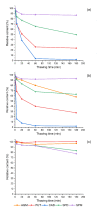Accumulation of Agmatine, Spermidine, and Spermine in Sprouts and Microgreens of Alfalfa, Fenugreek, Lentil, and Daikon Radish
- PMID: 32369919
- PMCID: PMC7278799
- DOI: 10.3390/foods9050547
Accumulation of Agmatine, Spermidine, and Spermine in Sprouts and Microgreens of Alfalfa, Fenugreek, Lentil, and Daikon Radish
Abstract
Sprouts and microgreens are a rich source of various bioactive compounds. Seeds of lentil, fenugreek, alfalfa, and daikon radish seeds were germinated and the contents of the polyamines agmatine (AGM), putrescine (PUT), cadaverine (CAD), spermidine (SPD), and spermine (SPM) in ungerminated seeds, sprouts, and microgreens were determined. In general, sprouting led to the accumulation of the total polyamine content. The highest levels of AGM (5392 mg/kg) were found in alfalfa microgreens, PUT (1079 mg/kg) and CAD (3563 mg/kg) in fenugreek sprouts, SPD (579 mg/kg) in lentil microgreens, and SPM (922 mg/kg) in fenugreek microgreens. A large increase in CAD content was observed in all three legume sprouts. Conversely, the nutritionally beneficial polyamines AGM, SPD, and SPM were accumulated in microgreens, while their contents of CAD were significantly lower. In contrast, daikon radish sprouts exhibited a nutritionally better profile of polyamines than the microgreens. Freezing and thawing of legume sprouts resulted in significant degradation of CAD, PUT, and AGM by endogenous diamine oxidases. The enzymatic potential of fenugreek sprouts can be used to degrade exogenous PUT, CAD, and tyramine at pH values above 5.
Keywords: biogenic amines; diamine oxidase; germination; lens culinaris; medicago sativa; polyamines; raphanus sativus; trigonella foenum-graecum.
Conflict of interest statement
The authors declare no conflict of interest.
Figures







References
-
- Kyriacou M.C., Rouphael Y., Di Gioia F., Kyratzis A., Serio F., Renna M., De Pascale S., Santamaria P. Micro-scale vegetable production and the rise of microgreens. Trends Food Sci. Technol. 2016;57:103–115. doi: 10.1016/j.tifs.2016.09.005. - DOI
-
- Gan R.Y., Lui W.Y., Wu K., Chan C.L., Dai S.H., Sui Z.Q., Corke H. Bioactive compounds and bioactivities of germinated edible seeds and sprouts: An updated review. Trends Food Sci. Technol. 2017;59:1–14. doi: 10.1016/j.tifs.2016.11.010. - DOI
-
- Kyriacou M.C., El-Nakhel C., Graziani G., Pannico A., Soteriou G.A., Giordano M., Ritieni A., De Pascale S., Rouphael Y. Functional quality in novel food sources: Genotypic variation in the nutritive and phytochemical composition of thirteen microgreens species. Food Chem. 2019;277:107–118. doi: 10.1016/j.foodchem.2018.10.098. - DOI - PubMed
Grants and funding
LinkOut - more resources
Full Text Sources
Other Literature Sources
Miscellaneous

